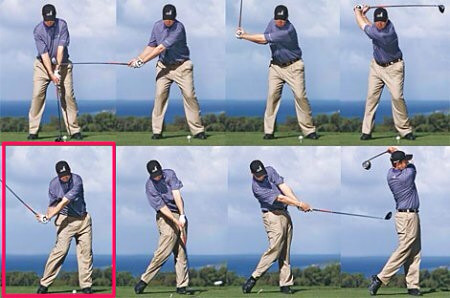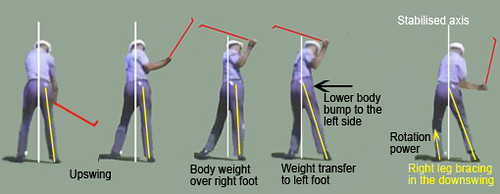I must have a ga-ja-billion posts on shaping shots (i.e., coaxing fades and draws), and that's because I'm always in search of the best way to do it. The best way is the way that is consistent and reliable for you to perform on the course (i.e., 90% of the time the ball bends as you intended). Click on the tags or keywords at the end of this post and you'll discover the numerous ways it's possible to influence the ball's starting line and follow-on ball flight.
I think this method--along with Jack's method--may be the easiest.
To fade the ball, tee up the ball LOW (even with the top of the driver) and on the right side of the tee box. Aim the club face towards the left side of the fairway (pick a tree or other target on the left); this represents the starting line. Place the club down aligned with this starting line. Make the address stance slightly open to the starting line; this means the hips, knees, feet, and shoulders should be aligned to the left. The upper body should still be tilted away from the target, and one must still shift the weight correctly and stay behind the ball for this power fade (sort of a push-fade, as you're still hitting inside-out ala Lee Trevino). Position the ball off the inside of the left instep (or roughly with the left shoulder). The further forward the ball position, the further left the ball should start on line before curving. Experiment with tee heights and ball position to get the right mix for the shot shape you want. Hit through the ball as if hitting four balls in a row on the starting line. Finally, use your normal grip, as most amateurs and high-handicappers hit with a slightly open club face even when trying to close it. Done correctly you should impart a nice, narrow fade on the ball.
To draw the ball, tee up the ball HIGH (one quarter to half the ball above the driver) and on the left side of the tee box. Pick a target on the left side of the fairway and place the club on that starting line. Make the address stance slightly closed to the starting line (pull the right foot back and align the shoulders and knees to the feet). Position the ball back in the stance (a few inches to the right of where it would be for the fade); the ball should be inside the left heel or roughly even with your shirt logo. Finally, rotate the club face slightly closed compared to the stance and then take your normal grip (most amateur golfers have trouble closing the club face enough for a push-draw, so manipulating the club at setup is easiest). Instead of hitting through all four balls, pretend you're hitting only the first ball of the four. Experiment to find the right mix; you will draw the ball (if you hook it then either move the ball slightly forward, tee it lower, lessen your closed stance, or try combinations of all).
A few notes. The lower the loft of the club (6-iron and up to driver), the easier it is to slice and the harder it is draw (another reason for manipulating the club face slightly closed for a draw). The higher the loft of the club (i.e., 7-iron and higher), the easier it is to hook and more difficult to fade. Draws tend to fly lower, further, and run more on landing. Fades tend to fly higher, shorter, and land with less roll. Take this into account when selecting a club. Don't be afraid to exaggerate adjustments to get the ball spinning like you want (i.e., if you lose your draw, get the ball hooking by standing with your back to the target and hitting balls).Full extension adds power and helps close the face (obviously useful for a draw but maybe for the fade too if the fade is too close to a slice). Hit both shots with the same swing shape--inside-out. And inside-out fade is called a power fade, and this was used by the greats like Hogan, Trevino, and Nicklaus.
Trevino’s swing is unorthodox, and so is his method for hitting the fade. The conventional way is to align the body left of target, aim the clubface at the target, and swing along the line of the body. Trevino follows the first two steps, but swings down the target line rather than with his body. The deviation actually produces a swing path that’s inside-to-out relative to the body, and directly down the target line. Trevino produces the left-to-right spin necessary for a fade by delaying the release (rolling over) of his hands through impact. According to Trevino, his routine produces more power than the traditional technique. He acknowledges that the ball will finish right of the target, but suggests simply lining up the body and clubface farther left to compensate.
Try Trevino's Unorthodox Power Fade Swing
Most players think of the swing as a circle. Trevino saw it as something different. Instead of folding his arms up after impact to remain on the circle, he chased his right shoulder toward the target to
the point where the club pointed straight down the line. He made this move with such force that it
looked like his right arm was going to rip straight out of its shoulder socket. It’s actually a move that most great ballstrikers have used over the decades.
Eventually, your left elbow must fold and get the club moving up the circle again, but try chasing down the line first, like Trevino did. I bet you’ll find yourself hitting the ball a little straighter and, if you can hold off your release just that much longer, creating a power fade. While the word “fade” has negative connotations for a chronic slicer, a controlled cut in the hands of a good player like Trevino leads to a Hall-of-Fame career, five Vardon Trophies and half a dozen major victories.
Johnny Miller - Lee Trevino signature chase move can help you hit it straighter | GOLF.com
"Inside out?" you might ask. "Doesn't that cause a draw?" Yes, it does, but only when your swing is inside out in relation to your target line. This swing is inside out in relation to the body alignment, but straight back to straight through in relation to the target line (see illustration). You won't draw the ball with this swing. If anything, you will contact the ball after the club has swung down and back to, the inside on the forward swing, thus putting a slight left to right spin on the ball .
So you have two big pluses here: First, you have an inside to outside attack in relation to your body. This is much more powerful than the outside-to inside swings that many amateurs use to fade the ball. Second, you have the club moving down the target line, producing either a straight ball or slight fade. You can't beat that combination.
Here's a trick that might help you understand this a little better. After you set up, imagine that there are three golf balls in front of the one you're about to hit. For the fade, you want to hit through all four balls. This will force your right shoulder down rather than around on the downswing, with your arms extending toward the target on the follow through. Keep in mind that the right shoulder doesn't dip. That would cause fat shots. Instead, the shoulder simply swivels underneath the chin. As a result, you will hold your release, keep the club moving down the target line, and push the ball to the hole, with very little sidespin.
I have, however, encountered one "problem" among people who have tried this method. They say to me, "Lee, when I swing your way, I hit the ball way to the right. I just tell them, "Aim farther left.” Don't open your stance more; just shift your entire orientation to the left. In other words, rather than aim the clubface down the fairway or at the pin, aim it at an intermediate target more to the left and shift your body alignment farther to the left as well. There's no rule that says you have to aim down the middle. Line up for the trees on the left and push it down the fairway. It's easy, when you know for sure that you can hit the push/fade.
The beauty of the balls in a line image is that you can use it to draw the ball, too. For the right to left shot, line up your body parallel to the target line and aim your clubface at an intermediate target to the right, to allow for the draw. Then, simply think of picking off the first ball in line, the real ball, without touching the three imaginary ones. This brings the right shoulder and club up quickly in the follow through, and whenever the club and shoulder move up, they go counterclockwise as well, which closes the clubface. Result: a draw.
You Can Learn to Hit My Fade - Lee Trevino - Golf Magazine - Dec 1979

